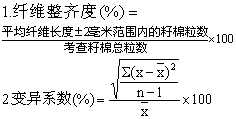纤维整齐度
棉纤维长短的整齐程度。有整齐度百分率、变异系数、晕长整齐指数3种表示方法。后者方法简便,代表性大,其值越高,可混纺纤维越多。

式中:x——各粒籽棉的纤维长度;——纤维长度平均值;
n——考查耔棉粒数;∑——各粒籽棉纤维长度的总和。

| 词条 | 纤维整齐度 |
| 类别 | 中文百科知识 |
| 释义 | 纤维整齐度棉纤维长短的整齐程度。有整齐度百分率、变异系数、晕长整齐指数3种表示方法。后者方法简便,代表性大,其值越高,可混纺纤维越多。
式中:x——各粒籽棉的纤维长度;——纤维长度平均值; n——考查耔棉粒数;∑——各粒籽棉纤维长度的总和。
|
| 随便看 |
开放百科全书收录579518条英语、德语、日语等多语种百科知识,基本涵盖了大多数领域的百科知识,是一部内容自由、开放的电子版国际百科全书。